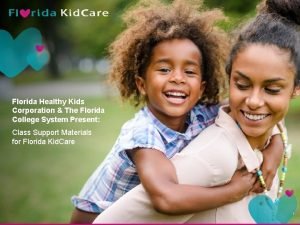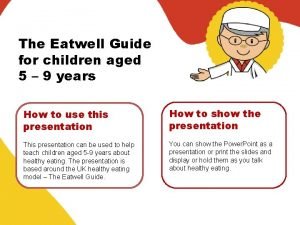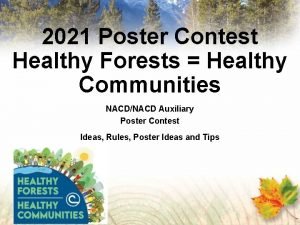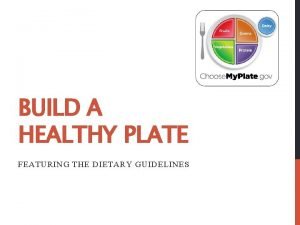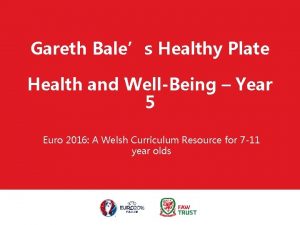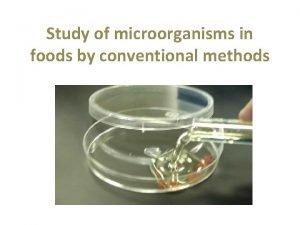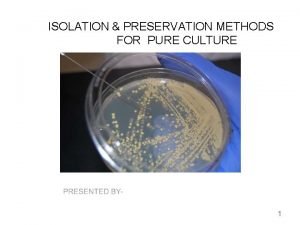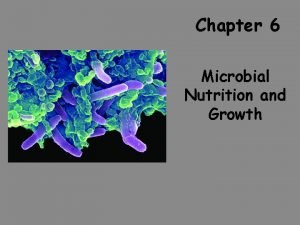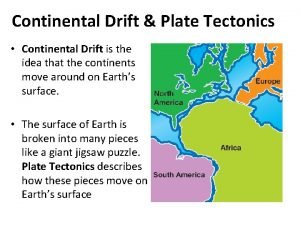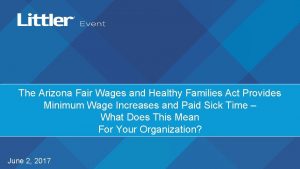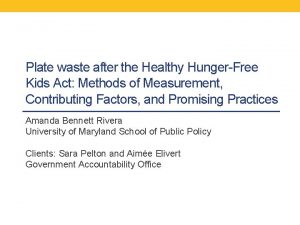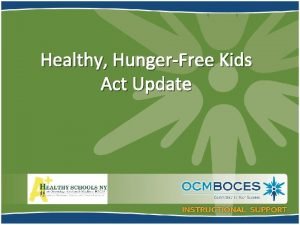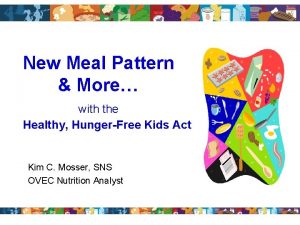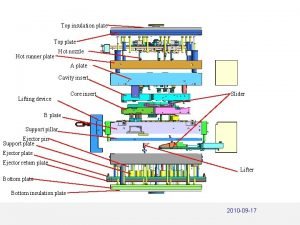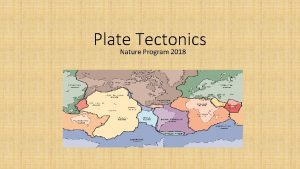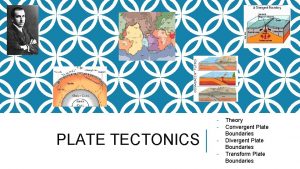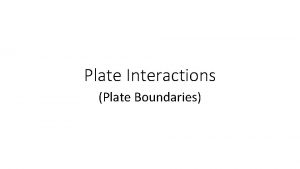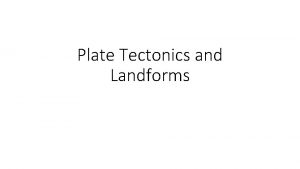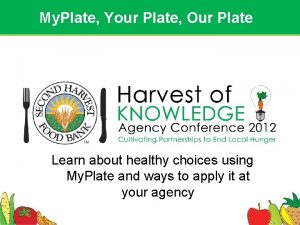Plate waste after the Healthy HungerFree Kids Act





















- Slides: 21

Plate waste after the Healthy Hunger-Free Kids Act: Methods of Measurement, Contributing Factors, and Promising Practices Amanda Bennett Rivera University of Maryland School of Public Policy Clients: Sara Pelton and Aimée Elivert Government Accountability Office

Background • The Healthy Hunger-Free Kids Act of 2010 gave the USDA authority to establish stricter nutrition standards in all foods sold in schools • Implementation began during the 2012 -2013 school year • Concerns about increased plate waste levels Source: New York Times article: “No Appetite for Good-for-You School Lunches” by Vivian Yee. Photo by Librado Romero.

Purpose • Determine the impact of the stricter nutritional standards of the Healthy Hunger-Free Kids Act (HHFKA) on plate waste • Identify methods to measure plate waste • Identify factors that contribute to plate waste • Identify promising practices to reduce plate waste

Comparison of Food Group Standards in the National School Lunch Program Before and After the Healthy Hunger-Free Kids Act Food Group Fruits and vegetables Vegetables Whole grains Milk Previous Requirements K-12 ½ - ¾ cup of fruit and vegetables combined per day No specifications as to type of vegetable subgroup Encouraged but not required 1 cup Variety of fat contents allowed; flavor not restricted Current Requirements K-12 ¾ - 1 cup of vegetables plus ½ -1 cup of fruit per day Note: Students are allowed to select ½ cup fruit or vegetable under OVS. Weekly requirement for: · dark green · red/orange · beans/peas (legumes) · starchy · other (as defined in 2010 Dietary Guidelines) At least half of the grains must be whole grain-rich beginning July 1, 2012. Beginning July 1, 2014, all grains must be whole grain rich 1 cup Must be fat-free(unflavored/flavored) or 1% low fat (unflavored) Adapted from Final Rule “Nutrition Standards in the National School Lunch and School Breakfast Programs” (2012).

Comparison of Nutrition Standards in the National School Lunch Program Before and After the Healthy Hunger-Free Kids Act Nutrient Standards Previous Requirements K-12 Current Requirements K-12 Minimum only based on grade. Lunch: 633 (grades K-3) 785 (grades 4 -12) 825 (optional grades 7 -12) Minimum and maximum limits based on grade. Lunch: 550 -650 (grades K-5) 600 -700 (grades 6 -8) 750 -850 (grades 9 -12) Sodium Reduce, no set targets Decreasing target limits based on grade. Target I: SY 201415; Target 2: SY 201718; Final target: 202223 Saturated fats <10% of total calories no limit zero grams per serving (nutrition label). (Less than 0. 5 grams count as zero) Calories Trans fats Adapted from Final Rule “Nutrition Standards in the National School Lunch and School Breakfast Programs” (2012).

Comparing Level of Challenge SFAs Report in Implementing the Updated Meal Patterns 100 90 80 70 60 50 40 30 20 10 0 59 62, 4 32, 4 23, 4 SY 2012 -13 SY 2013 -14 School Year Challenge: Student Acceptance Percent of SFAs Challenge: Maintaining Budget/ Food Costs 100 90 80 70 60 50 40 30 20 10 0 58, 8 56, 7 35 24 SY 2012 -13 SY 2013 -14 School Year A Little or Moderately Challenging Very and Extremely Challenging Adapted from Special Nutrition Program Operations Study (SN-OPS) SY 2013 -14 Report. Data from SFA Director Survey SY 2012 -13, questions 5. 3 and 5. 4; SFA Director Survey SY 2013 -14, question 5. 1

METHODOLOGY

Literature Review • Based on a 2015 Congressional Research Service report: “Implementation of Updated School Meals Nutrition Standards: A Summary of Related Reports and Research” • Data collected: • Year of data collection • Study design/ methodology • Setting • Eligibility for Free and Reduced Lunch • Selected Findings • Limitations • Author’s recommendations

Agency and Organization Website Review Agency or Organization Program(s) United States Department of Agriculture (USDA) Creative Solutions Resources & Fresh Fruit and Vegetable Program Environmental Protection Agency (EPA) Schools: Food Recovery Challenge US Department of Education Green Ribbon Schools School Nutrition Foundation & Environmental Research and Education Foundation (EREF) National Parent Teacher Association (PTA) SCr. AP: School Cafeteria Discard Assessments Project Healthy School Meals Initiative Pew Charitable Trusts Kids' Safe and Healthful Foods Project Cornell University Smarter Lunchrooms Movement

Interviews • Luke Wolfgang, Sustainability Coordinator- US EPA Region III • Stephanie Scarmo and Mollie Van Lieu, Safe Food Project and Kids’ Safe and Healthful Food Project- Pew Charitable Trusts • Janet Hedrick- School Nutrition Foundation • Jean Ronnei, SNS, Senior Consultant- Pro-Team Foodservice Advisors • Chelsea Smyth, School Meals Fellow- National PTA • Patrice Puertollano, RD- Prince George's County Schools Food and Nutrition Services

FINDINGS

Weight and Volume Method Source: School Cafeteria Discards Assessment Project-Scrap

Photography Source: Taylor, J. C. , B. A. Yon, and R. K. Johnson. 2014

Observation

Student Recall and Interviews

Evaluation of Plate Waste Methodologies Method Weight and Volume High. Considered the Validity golden standard Cost High Photography Observation Student Recall and Interviews High Medium Low

Factors Contributing to Plate Waste • Taste • Preparation • Adjustment to nutritional standard changes • Duration of lunch period • Timing of recess • Lunch shaming Picture source: How to Conduct a School Grade 6 -12 Leftover Food and Beverage Assessment. Presentation by André Villaseñor (EPA, 2017)

Promising Practices • Smarter Lunchrooms Movement • Keep age in mind • Offer samples of new foods • Competitive food placement • Increase lunch time • Schedule recess before lunch • Engage parents

Limitations • The majority of the studies included in this report focus only on the lunch program • Limited number of studies examining plate waste after the implementation of new standards • Most of the studies are not generalizable to the American population

Analysis & Recommendations • Address the needs of local schools • Allow children more time to become accustomed to the new nutrition standards • Conduct more research in order to increase generalizability of studies

Thank you Photo: Nicholas Griner/Howard County Public School System Source: https: //www. wsj. com/articles/how-schools-can-get-children-to-eat-theirvegetables-1487944388
 After me after me after me
After me after me after me John 14:1-3
John 14:1-3 Kids r kids west cobb
Kids r kids west cobb Florida healthy kids corporation
Florida healthy kids corporation Eatwell guide children
Eatwell guide children Healthy food healthy mind journal
Healthy food healthy mind journal Healthy soil healthy life poster ideas
Healthy soil healthy life poster ideas Healthy community poster
Healthy community poster Healthy nurse healthy nation
Healthy nurse healthy nation Siobhan jennings
Siobhan jennings Build a healthy plate worksheet answers
Build a healthy plate worksheet answers Balanced diet food plate
Balanced diet food plate Pour plate and spread plate difference
Pour plate and spread plate difference Pure culture
Pure culture Pour plate vs streak plate
Pour plate vs streak plate A denser oceanic plate collides with a continental plate
A denser oceanic plate collides with a continental plate Converging continental plate and oceanic plate oreo
Converging continental plate and oceanic plate oreo Macbeth act 2 summary
Macbeth act 2 summary Arizona fair wages and healthy families act
Arizona fair wages and healthy families act Hình ảnh bộ gõ cơ thể búng tay
Hình ảnh bộ gõ cơ thể búng tay Slidetodoc
Slidetodoc Bổ thể
Bổ thể



